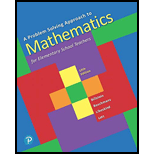
Concept explainers
To estimate the number of fish in a lake, scientists use a tagging and recapturing technique. A number of fish are captured, tagged, and then released back into the lake. After a while, some fish are captured and the number of tagged fish is counted.
Let T be the total number of fish captured, tagged, and released into the lake, n the number of fish in a recaptured sample, and t the number of fish found tagged in that sample. Finally, let x be the number of fish in the lake. The assumption is that the ratio between tagged fish and the total number of fish in any sample is approximately the same, and hence scientists assume
Want to see the full answer?
Check out a sample textbook solution
Chapter 6 Solutions
Problem Solving Approach to Mathematics for Elementary School Teachers
- 9 (Portfolio allocation) Suppose R₁ and R2 are returns of 2 assets and with expected return and variance respectively r₁ and 72 and variance-covariance σ2, 0%½ and σ12. Find −∞ ≤ w ≤ ∞ such that the portfolio wR₁ + (1 - w) R₂ has the smallest risk.arrow_forward7 (Multivariate random variable) Suppose X, €1, €2, €3 are IID N(0, 1) and Y2 Y₁ = 0.2 0.8X + €1, Y₂ = 0.3 +0.7X+ €2, Y3 = 0.2 + 0.9X + €3. = (In models like this, X is called the common factors of Y₁, Y₂, Y3.) Y = (Y1, Y2, Y3). (a) Find E(Y) and cov(Y). (b) What can you observe from cov(Y). Writearrow_forward1 (VaR and ES) Suppose X ~ f(x) with 1+x, if 0> x > −1 f(x) = 1−x if 1 x > 0 Find VaRo.05 (X) and ES0.05 (X).arrow_forward
- (^) k Recall that for numbers 0 ≤ k ≤ n the binomial coefficient (^) is defined as n! k! (n−k)! Question 1. (1) Prove the following identity: (22) + (1121) = (n+1). (2) Use the identity above to prove the binomial theorem by induction. That is, prove that for any a, b = R, n (a + b)" = Σ (^) an- n-kyk. k=0 n Recall that Σ0 x is short hand notation for the expression x0+x1+ +xn- (3) Fix x = R, x > 0. Prove Bernoulli's inequality: (1+x)" ≥1+nx, by using the binomial theorem. - Question 2. Prove that ||x| - |y|| ≤ |x − y| for any real numbers x, y. Question 3. Assume (In) nEN is a sequence which is unbounded above. That is, the set {xn|nЄN} is unbounded above. Prove that there are natural numbers N] k for all k Є N. be natural numbers (nk Є N). Prove thatarrow_forwardQuestion content area top Part 1 Find the measure of ABC for the congruent triangles ABC and Upper A prime Upper B prime Upper C primeA′B′C′. 79 degrees79° 1533 2930 Part 1 m ABCequals=enter your response heredegreesarrow_forwardJoy is making Christmas gifts. She has 6 1/12 feet of yarn and will need 4 1/4 to complete our project. How much yarn will she have left over compute this solution in two different ways arrow_forward
- Solve for X. Explain each step. 2^2x • 2^-4=8arrow_forwardFind the range and all the answers. Remark that the range isn’t between -(pi/2) and (pi/2)arrow_forwardOne hundred people were surveyed, and one question pertained to their educational background. The results of this question and their genders are given in the following table. Female (F) Male (F′) Total College degree (D) 30 20 50 No college degree (D′) 30 20 50 Total 60 40 100 If a person is selected at random from those surveyed, find the probability of each of the following events.1. The person is female or has a college degree. Answer: equation editor Equation Editor 2. The person is male or does not have a college degree. Answer: equation editor Equation Editor 3. The person is female or does not have a college degree.arrow_forward
 Algebra: Structure And Method, Book 1AlgebraISBN:9780395977224Author:Richard G. Brown, Mary P. Dolciani, Robert H. Sorgenfrey, William L. ColePublisher:McDougal Littell
Algebra: Structure And Method, Book 1AlgebraISBN:9780395977224Author:Richard G. Brown, Mary P. Dolciani, Robert H. Sorgenfrey, William L. ColePublisher:McDougal Littell Glencoe Algebra 1, Student Edition, 9780079039897...AlgebraISBN:9780079039897Author:CarterPublisher:McGraw Hill
Glencoe Algebra 1, Student Edition, 9780079039897...AlgebraISBN:9780079039897Author:CarterPublisher:McGraw Hill Holt Mcdougal Larson Pre-algebra: Student Edition...AlgebraISBN:9780547587776Author:HOLT MCDOUGALPublisher:HOLT MCDOUGAL
Holt Mcdougal Larson Pre-algebra: Student Edition...AlgebraISBN:9780547587776Author:HOLT MCDOUGALPublisher:HOLT MCDOUGAL
 Big Ideas Math A Bridge To Success Algebra 1: Stu...AlgebraISBN:9781680331141Author:HOUGHTON MIFFLIN HARCOURTPublisher:Houghton Mifflin HarcourtAlgebra & Trigonometry with Analytic GeometryAlgebraISBN:9781133382119Author:SwokowskiPublisher:Cengage
Big Ideas Math A Bridge To Success Algebra 1: Stu...AlgebraISBN:9781680331141Author:HOUGHTON MIFFLIN HARCOURTPublisher:Houghton Mifflin HarcourtAlgebra & Trigonometry with Analytic GeometryAlgebraISBN:9781133382119Author:SwokowskiPublisher:Cengage





